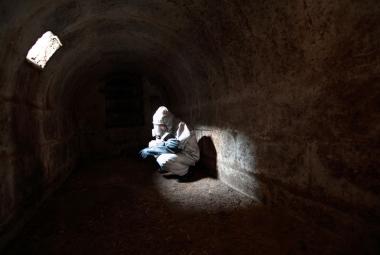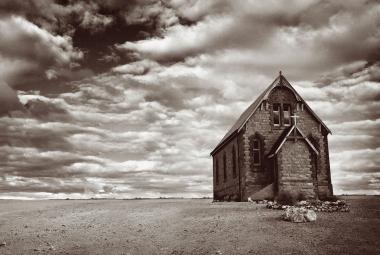The foundation for the Sanhedrin can be found in the Council of the seventy elders established by Moses, “So the LORD said to Moses: “Gather to Me seventy men of the elders of Israel, whom you know to be the elders of the people and officers over them; bring them to the tabernacle of meeting, that they may stand there with you.” 1
At this point it is important to note that the term Sanhedrin is not actually a Hebrew word. The name comes from the Greek: συνέδριον (synedrion) meaning: “sitting together.” Counting Moses, it consisted of 71 members. According to the Jewish Virtual Library, “It was the final authority on Jewish law and any scholar who went against its decisions was put to death as a rebellious elder. The Sanhedrin was led by a president called the nasi (lit. “prince”) and a vice president called the av bet din (lit. “father of the court”). The other 69 sages sat in a semi-circle facing the leaders. It is unclear whether the leaders included the high priest.”2
The authority of the Sanhedrin continued through the times of the Kings as we read, “Moreover in Jerusalem, for the judgment of the LORD and for controversies, Jehoshaphat appointed some of the Levites and priests, and some of the chief fathers of Israel, when they returned to Jerusalem.” 3
There are 22 New Testament references to the “councils” (K.J.V.) that were active during the time of the ministry of Jesus. In fact, Jesus was most likely tried by this body of judges (Matthew 26:59; Mark 14:55; and Luke 22:66,67). The apostles were brought before them (Acts 5), and the first martyr, Stephen, was arrested and tried by them (Acts 6:8-15). In about AD 30, the Great Sanhedrin lost its authority to inflict capital punishment and thus faded on the political stage in Israel.
Disbanding the Sanhedrin
Before AD 70, Raban Yohanan (John) Ben Zakay flees Jerusalem in a coffin, pretending to be dead, and so reaches Vespasian. He predicted Vespasian would become emperor. When he did, he asked the Sanhedrin to be allowed to resume in Yanve.4 Thus, the Sanhedrin took refuge by permission of Vespasian in Yanve, where they continued as the “councilors of the Jews.” This dislocated Sanhedrin operated under the leadership of Rabban Gamaliel II, the grandson of Rabban Gamaliel I who is the one referenced in Acts 22:3 where it is said that he was Paul’s teacher and in Acts 5:34-40, where he encourages the Sanhedrin to show tolerance toward the then-new Christian church.
Following the destruction of the Jerusalem Temple, the Sanhedrin fled, moving from site to site until AD 193, then the members made their final move to Tiberias. In AD 358, the Roman Emperor Theodosius disbanded the Sanhedrin and declared it illegal, under pain of execution, to grant ordination to new Sanhedrin members or issue new court rulings. In the closing years of this academic center, the Jerusalem Talmud was compiled. The Talmud is a collection of commentaries on the oral and written traditions of the Jews and is the primary source of Jewish religious law and Jewish theology.
Rotten Roots of the Sanhedrin?
A 1961 archaeological dig just south of the present-day city of Tiberias uncovered a basilica structure that, archaeologists believe, may have served as the Sanhedrin’s seat in Tiberias. During our 2019 B.A.S.E. Tour to Israel, we noticed that the floor of this fourth-century synagogue has the images of the Zodiac wheel, featuring, among other pagan images, depictions of naked humans—including a conspicuously uncircumcised Libra. The wheel encircles a haloed Helios, the Greek sun god, mounted atop his chariot. If this truly was the home of the last formal Sanhedrin in Israel, then it has a sad tale to tell of the influence of pagan ideas embedded within the foundation of the synagogue where the Jerusalem Talmud was compiled.
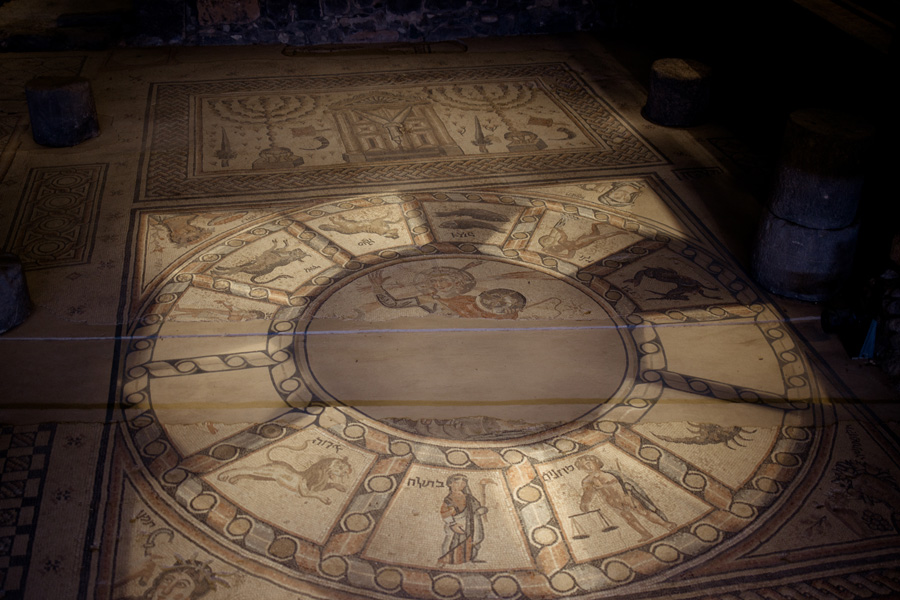

The synagogue at Beth Alpha near Gilboa is another wonderful example of the infiltration of the Zodiac wheel into the foundation of Jewish theological thinking.
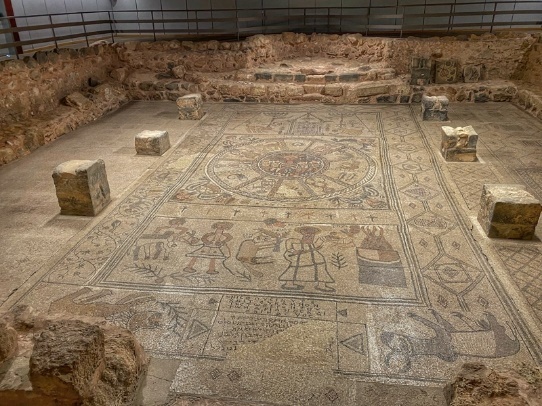
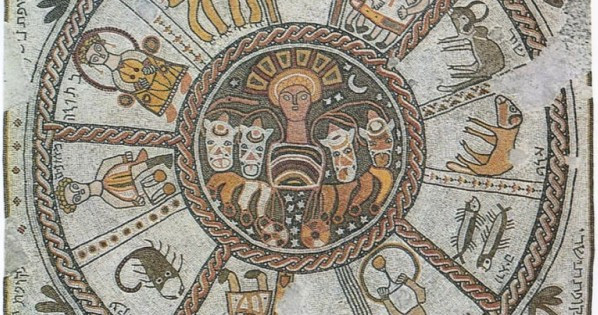 Sepphoris (Tzippori) is a third archaeological site to be considered. It is located in the central Galilee region of Israel, 3.7 miles (6 km) north-northwest of Nazareth. Once again, we see the pagan influence laid out on the floor of this synagogue. Here, in AD 200, the Rabbi Yehuda Hasasi, edited and published the oral law as a canonic text called the “Mishna”, meaning “secondary.” This is the “Second Torah”, and it can be seen as a Jewish equivalent to the “New Testament.” The Mishna was later transferred to Babylon, and there, far from the Roman/Byzantine empire the Rabbis wrote the official version of the Talmud: the Babylonian Talmud.
Sepphoris (Tzippori) is a third archaeological site to be considered. It is located in the central Galilee region of Israel, 3.7 miles (6 km) north-northwest of Nazareth. Once again, we see the pagan influence laid out on the floor of this synagogue. Here, in AD 200, the Rabbi Yehuda Hasasi, edited and published the oral law as a canonic text called the “Mishna”, meaning “secondary.” This is the “Second Torah”, and it can be seen as a Jewish equivalent to the “New Testament.” The Mishna was later transferred to Babylon, and there, far from the Roman/Byzantine empire the Rabbis wrote the official version of the Talmud: the Babylonian Talmud.
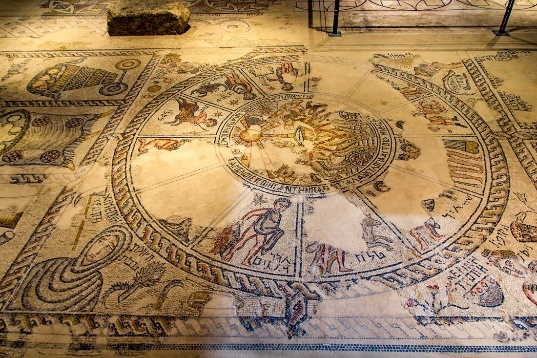
I think it is safe to say that based on these three examples of mosaic floor coverings the fourth-century Jewish theologians abandoned their abhorrence of images as prescribed in the Mosaic Law, which states, “You shall not make for yourself a carved image--any likeness of anything that is in heaven above, or that is in the earth beneath, or that is in the water under the earth.” 6 The more mankind accommodates false representations of God, the more those images find a comfortable home in both heart and mind. This was true even for the Sanhedrin.
Re-establishing the Sanhedrin
Post the exile imposed by the Romans, there have been many attempts to reconvene this governing body of Jewish scholars. Since the dissolution of the Sanhedrin in AD 358, no universally recognized authority has been established. The twelfth-century scholar, Maimonides, discussed the seeming incompatibility of the essential requirement of Jewish Law for a Sanhedrin and the inability to form one due to the loss of semikhah (the formal transmission of authority from Moses through the generations).
Maimonides – based on a tradition he had in his family and from his teachers – believed that the Sanhedrin will not necessarily be renewed miraculously by the Messiah. He wrote that if the sages of Israel who lived in the Land of Israel would gather together and choose one among them as worthy of ordination, then he would be considered to have been ordained with the original ordination. He, in turn, could ordain 69 or 70 men until the entire Sanhedrin was reconstituted.7
Based on this simple solution, an agreement of the “sages of Israel” could choose and ordain a nasi (lit. “prince”), who would be responsible to populate the remainder of the 70-seat Sanhedrin.
In the last five hundred years, there have been a few unsuccessful attempts to re-establish a Sanhedrin:
- In 1538 by Rabbi Jacob Berab
- In 1830 by Rabbi Yisroel Shklover
- In 1901 by Rabbi Aharon Mendel haCohen
- In 1940 by Rabbi Zvi Kovsker and
- In 1949 by Rabbi Yehuda Leib Maimon
Several websites report that “in 2004 on the shores of the Sea of Galilee in Tiberias a new Sanhedrin was established.”8,9 Apparently, this organization referred to itself as the nascent Sanhedrin, or “developing Sanhedrin” and regarded itself as a provisional body awaiting integration into the Israeli government as both a supreme court and an upper house of the Knesset. Even though the Israeli secular press regards it as an illegitimate fundamentalist organization of rabbis, this group, by consensus, elected Rabbi Moshe Halberstam as the nasi; unfortunately, he died shortly afterward in 2006 at the age of 74.10
A spokesman said,
The rebirth of the Sanhedrin is a slow, ongoing process. Although it makes headlines and many like to highlight its controversy, it is, in truth, a humble project by rabbis from all sides of the Torah world joining together simply to fulfill a Torah commandment. Rather than a source of religious division, G-d forbid, it is a vehicle to bring about Jewish unity and civil justice, to help repair some of the deepest rifts in our society, and to provide an active, exemplary, and unified Torah leadership so lacking in our times.11
On a practical level, the newly formed Sanhedrin focuses on the following key issues:12
- Collect opinions as to the exact location of the Temple on the Temple Mount
- Create unity from all sides of Torah understanding
- Seeking ties with various academic scholars and institutions
- Preparing a renewed priesthood (including the high priest), for the rebuilding of the Third Temple in Jerusalem
New Home for the Sanhedrin?
An incredibly significant ceremony took place 20 December 2017. “The timing of the dedication ceremony was not coincidental – it was held on the seventh night of Hanukkah, which was also Rosh Chodesh.”13 “Rosh Chodesh, the first day of the lunar month, is called literally “the head of the month” and not the “beginning of the month”, because just as the head contains the life-force for all the limbs, so does the first day of each month represent the spiritual ‘life-force’ for the rest of the month.”14 This has deeply spiritual significance. “Whoever pronounces the blessing over the new moon in its due time welcomes, as it were, the presence of the Shechinah.”15
“Immediately following the lighting of the seventh candle of Hanukkah at the Western Wall by the Ashkenazi Chief Rabbi of Jerusalem, Rabbi Aryeh Stern, and Mr. Eli Groner, Director-General of the Prime Minister’s Office, a new synagogue was inaugurated in the Western Wall tunnels.
“The magnificent $50m synagogue is the result of 12 years of structural support, construction, and archeological work, in which activities were carried out to maintain and preserve the impressive cavern in which it is located in the tunnels. The synagogue is located opposite the ‘Great Stone’ in the Western Wall tunnels, near the site of the Holy of Holies.”16
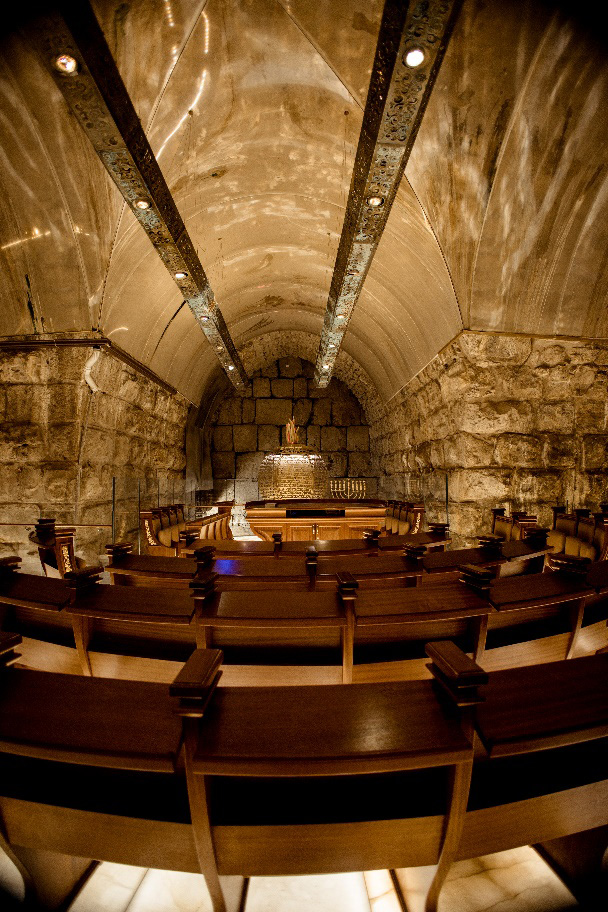
This new facility has 71 seats in a semi-circle facing a golden “ark.” Sound familiar? The round ark is made of sculpted metal incorporating the letters of the verses “Shema Yisrael,” “Ana Bako’ach” and the “Song of Songs” scroll, with a sculpture of the burning bush.17
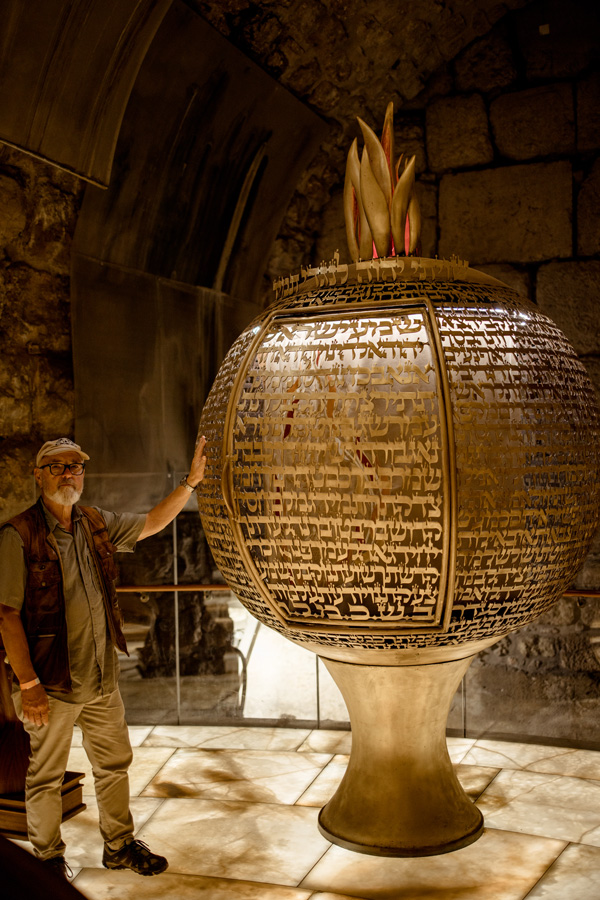
Broadening the Reach of the Sanhedrin?
If the summary goal of this new Sanhedrin as described is “a vehicle to bring about Jewish unity and civil justice,”18 how far will the arms of their doctrinal tolerance expand? Do the Kabbalists have a seat among this distinguished body of Talmudic scholars? Will the ancient sons of Ishmael be reunited with the sons of Isaac?
In researching this new synagogue near the Western Wall, my attention was immediately drawn to the Kabbalistic prayer included in the central Torah Ark.
The Ana Beko’ach is hidden within the first 42 letters of the book of Genesis, beginning with the word bereshit and ending with the word vavohoo. Referred to as the 42-letter name of God, the source of the efficacy of this prayer is indicated to us by where it is revealed in the Bible – at the very beginning, in the story of Creation itself. The kabbalists explain that each time we recite the Ana Beko’ach, we return to the time of Creation, and each time we meditate on a particular sequence, we return to the original uncorrupted energy that built the world. By performing the Ana Beko’ach meditation, we enrich our lives with unadulterated spiritual Light and cosmic energy.19
Another interesting development took place in September 2005 when a member of the Sanhedrin presided over the early steps to form a High Council for those in the Noahide movement. Six council members were selected at a small conference held in California. They appeared before the Senhedrin in Jerusalem the following January where they were ordained to form the council.20
Noahidism is a monotheistic Jewish religious movement based upon the Seven Laws of Noah and their traditional interpretations within Orthodox Judaism. The Seven Laws of Noah are:21
- Do not worship idols.
- Do not curse God.
- Do not murder.
- Do not commit adultery or sexual immorality.
- Do not steal.
- Do not eat flesh torn from a living animal.
- Establish Courts of Justice to build upon these laws.
According to Jewish law, non-Jews (Gentiles) are not obligated to convert to Judaism, but they are required to observe the Seven Laws of Noah to be assured of a place in the World to Come (Olam Ha-Ba), the final reward of the righteous. The core of Noahide belief revolves around adherence to the Seven Noahide Laws as God’s original covenant with all mankind (prior to the Abrahamic covenant and the subsequent Mosaic covenant with the Jewish people). Following the Noahide laws includes a complete rejection of former Christian beliefs, specifically belief in the divinity of Jesus, which constitutes idolatry and is forbidden according to the Jewish interpretation of the first law, “Do not deny God.”22
It is interesting to note that this new openness to Noahidism means that Muslims are not guilty of idolatry and therefore, they could be included in a wider interpretation of the Abrahamic covenant.
Maimonides (1135–1204) strongly put forth the view that Muslims were not idolaters. Although Islam is considered heresy because Muslims replaced the Torah with the Quran, this did not stop Maimonides from expressing a positive view about Islam - or even about Christianity, which he considered to be idolatry. He ruled that although Islam and Christianity are both in error, they still have some value in that they prepare the world eventually to accept the sovereignty of G-d.23
To demonstrate the early growth of this ecumenical movement based on the principles of Noahidism, “in April 2006, the spiritual leader of the Druze community in Israel, Sheikh Mowafak Tarif, met with a representative of Chabad-Lubavitch (a branch of Hasidic Judaism) to sign a declaration calling on all non-Jews in Israel to observe the Noahide Laws. The mayor of the Galilean city of Shefa-‘Amr (Shfaram) — where Muslim, Christian, and Druze communities live side-by-side — also signed the document.”24
All man-controlled ecumenical efforts are ultimately drawn into the vortex of the lowest common denominator, which naturally diminishes distinction in the interest of unity. Through this view of unity, differences are viewed as destructive. Therefore, any who are outside of the accepted, ecumenically defined, inner circle are considered dissidents and are marginalized for the overall good of unity. Remember, danger lies where discernment is lost.
One Name for All
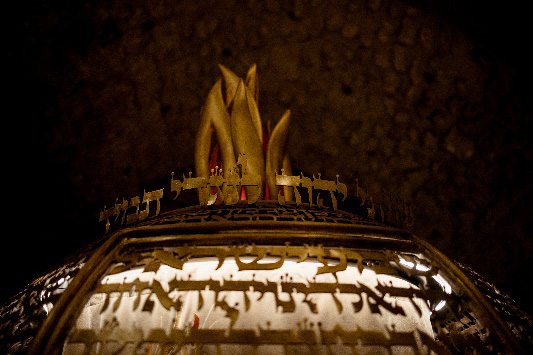
Above the Torah Ark in this new synagogue is a crown made up of the Hebrew Shiviti, which states,
שִׁוִּיתִי יְהוָה לְנֶגְדִּי תָמִיד׃
Shiviti YHVH l’negdi tamid
“I have set YHVH before me at all times” — the first part of Psalm 16:8. Proponents of this meditative chant say, “Given the fact that the Torah forbids impressing our imaginations with illustrations of the divine, some other method is necessary to perceive divine Oneness. Because the object of any given practice is to condition behavior through repetition, the practice of perceiving the world as an expression of divine Oneness can begin as soon as one gains consciousness, and this is where
Psalms 16:8 [the Shiviti] enters into the morning liturgy.”25
One must forever keep in mind the Creator’s omnipresence and that His Shechinah is with you at all times. One must always be joyful, keeping in mind and believing with absolute faith that the Shechinah is with him and guards him; he is bound up with the Creator, and the Creator is bound up with him in all his limbs and faculties. He looks upon the Creator, and the Creator looks upon him. All good things, as well as judgments in the world, are rooted in G-d, for His effluence and vitality are in everything; thus, I trust but in Him, and fear but Him, blessed be He.26
Each time I visit Israel, I am increasingly confronted by those who honestly believe that the ultimate role of religion in Israel is to bring about world unity and, thereby, peace. Many of my Jewish friends now refer to the G-d of the Bible as “the Creator,” thus avoiding the snare of using a specific name that might offend the hearer.
What IF…
- This new Synagogue in Jerusalem is the home of the new Sanhedrin?
- The new Sanhedrin appoints a nasi that is seen as a “man of peace?
- This new nasi can draw in the other monotheist religions of the world, including Islam and Christianity?
- This new Sanhedrin achieves its goal of bringing world peace by uniting the world’s religions?
- This new nasi convinces these world religious leaders to forgo the idea of building a literal Jewish Temple on the Temple Mount in lieu of an alternative metaphysical solution?
- This new nasi introduces the idea that animal sacrifices are no longer necessary?
- This new nasi produces many miracles that amaze the nations?
- This new nasi declares before the Sanhedrin that “he is god” standing in this holy place?
One more thought for you to consider. I have been told that this new Synagogue is called “Shaare Teshuva” which literally means “gates of return.”
The word Teshuvah is usually translated as repentance. But this translation is not entirely accurate. Teshuvah is better translated as ‘return’ and signifies a return to the original state. Kabbalistically, Teshuvah takes on more of a cosmic dynamic. The word Teshuvah in Hebrew may be read ‘tashuv hey,’ literally” ‘returning the letter Hey.’ The last letter Hey of the Tetragrammaton refers to Malchut (Kingdom). Malchut is synonymous with Shechinah, which is how G-d manifests Himself as a sovereign within the creation.27
So, if we put all of this together, we have a new Sanhedrin, presiding in a new synagogue named “Shaare Teshuva” which mystically means “Gates of the Return of the Shechinah.”
No one can know with absolute certainty what the future holds. In the Olivet Discourse, Jesus gave this simple eschatological advice to His disciples, “Now learn this parable from the fig tree: When its branch has already become tender and puts forth leaves, you know that summer is near. So, you also when you see all these things, know that it is near--at the doors!”28
The critical thinker as embodied in the Sons of Issachar will not reach a hasty conclusion on these matters. Further investigation and discovery will refine or refute the implications suggested by this article. Please feel free to send us your comments.




